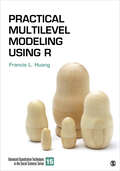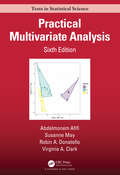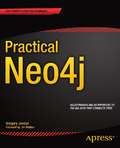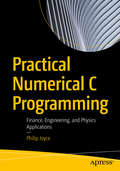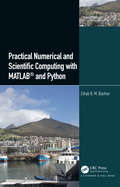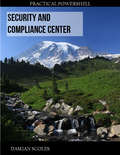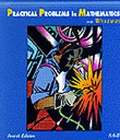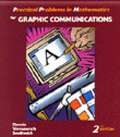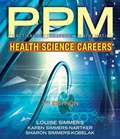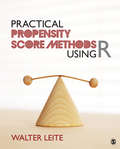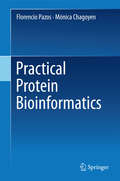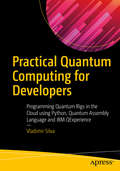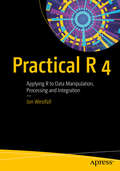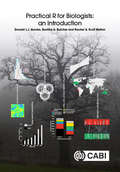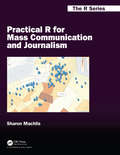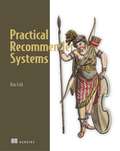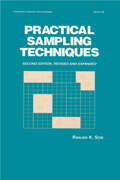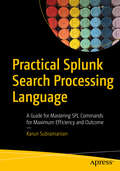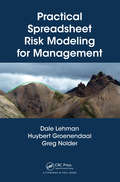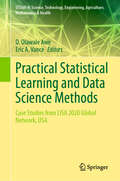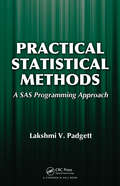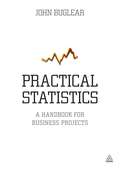- Table View
- List View
Practical Multilevel Modeling Using R (Advanced Quantitative Techniques in the Social Sciences)
by Francis L. HuangPractical Multilevel Modeling Using R provides students with a step-by-step guide for running their own multilevel analyses. Detailed examples illustrate the conceptual and statistical issues that multilevel modeling addresses in a way that is clear and relevant to students in applied disciplines. Clearly annotated R syntax illustrates how multilevel modeling (MLM) can be used, and real-world examples show why and how modeling decisions can affect results. The book covers all the basics but also important advanced topics such as diagnostics, detecting and handling heteroscedasticity, power analysis, and missing data handling methods. Unlike other detailed texts on MLM which are written at a very high level, this text with its applied focus and use of R software to run the analyses is much more suitable for students who have substantive research areas but are not training to be methodologists or statisticians. Each chapter concludes with a "Test Yourself" section, and solutions are available on the instructor website for the book. A companion R package is available for use with this text.
Practical Multilevel Modeling Using R (Advanced Quantitative Techniques in the Social Sciences)
by Francis L. HuangPractical Multilevel Modeling Using R provides students with a step-by-step guide for running their own multilevel analyses. Detailed examples illustrate the conceptual and statistical issues that multilevel modeling addresses in a way that is clear and relevant to students in applied disciplines. Clearly annotated R syntax illustrates how multilevel modeling (MLM) can be used, and real-world examples show why and how modeling decisions can affect results. The book covers all the basics but also important advanced topics such as diagnostics, detecting and handling heteroscedasticity, power analysis, and missing data handling methods. Unlike other detailed texts on MLM which are written at a very high level, this text with its applied focus and use of R software to run the analyses is much more suitable for students who have substantive research areas but are not training to be methodologists or statisticians. Each chapter concludes with a "Test Yourself" section, and solutions are available on the instructor website for the book. A companion R package is available for use with this text.
Practical Multivariate Analysis (Chapman & Hall/CRC Texts in Statistical Science)
by Susanne May Abdelmonem Afifi Virginia A. Clark Robin DonatelloThis is the sixth edition of a popular textbook on multivariate analysis. Well-regarded for its practical and accessible approach, with excellent examples and good guidance on computing, the book is particularly popular for teaching outside statistics, i.e. in epidemiology, social science, business, etc. The sixth edition has been updated with a new chapter on data visualization, a distinction made between exploratory and confirmatory analyses and a new section on generalized estimating equations and many new updates throughout. This new edition will enable the book to continue as one of the leading textbooks in the area, particularly for non-statisticians. Key Features: Provides a comprehensive, practical and accessible introduction to multivariate analysis. Keeps mathematical details to a minimum, so particularly geared toward a non-statistical audience. Includes lots of detailed worked examples, guidance on computing, and exercises. Updated with a new chapter on data visualization.
Practical Neo4j
by Gregory JordanWhy have developers at places like Facebook and Twitter increasingly turned to graph databases to manage their highly connected big data? The short answer is that graphs offer superior speed and flexibility to get the job done. It's time you added skills in graph databases to your toolkit. In Practical Neo4j, database expert Greg Jordan guides you through the background and basics of graph databases and gets you quickly up and running with Neo4j, the most prominent graph database on the market today. Jordan walks you through the data modeling stages for projects such as social networks, recommendation engines, and geo-based applications. The book also dives into the configuration steps as well as the language options used to create your Neo4j-backed applications. Neo4j runs some of the largest connected datasets in the world, and developing with it offers you a fast, proven NoSQL database option. Besides those working for social media, database, and networking companies of all sizes, academics and researchers will find Neo4j a powerful research tool that can help connect large sets of diverse data and provide insights that would otherwise remain hidden. Using Practical Neo4j, you will learn how to harness that power and create elegant solutions that address complex data problems. This book: Explains the basics of graph databasesDemonstrates how to configure and maintain Neo4jShows how to import data into Neo4j from a variety of sourcesProvides a working example of a Neo4j-based application using an array of language of options including Java, . Net, PHP, Python, Spring, and RubyAs you'll discover, Neo4j offers a blend of simplicity and speed while allowing data relationships to maintain first-class status. That's one reason among many that such a wide range of industries and fields have turned to graph databases to analyze deep, dense relationships. After reading this book, you'll have a potent, elegant tool you can use to develop projects profitably and improve your career options.
Practical Numerical C Programming: Finance, Engineering, and Physics Applications
by Philip JoyceMaster the C code appropriate for numerical methods and computational modeling, including syntax, loops, subroutines, and files. Then, this hands-on book dives into financial applications using regression models, product moment correlation coefficients, and asset pricing. Next, Practical Numerical C Programming covers applications for engineering/business such as supermarket stock reordering simulation as well as flight information boards at airports and controlling a power plant. Finally, the book concludes with some physics including building simulation models for energy and pendulum motion. Along the way, you’ll learn center-of-mass calculations, Brownian motion, and more. After reading and using this book, you'll come away with pragmatic case studies of actual applications using C code at work. Source code is freely available and includes the latest C20 standard release. What You Will Learn Apply regression techniques to find the pattern for depreciation of the value of cars over a period of years Work with the product moment correlation coefficient technique to illustrate the accuracy (or otherwise) of regression techniques Use the past stock values of an asset to predict what its future values may be using Monte Carlo methods Simulate the buying of supermarket stock by shoppers and check the remaining stock: if it is too low print a message to reorder the stock Create a file of arrivals for an airport and send data to the airport’s display boards to show the current situation for the incoming flights Simulate the patterns of particles moving in gases or solids Who This Book Is For Programmers and computational modelers with at least some prior experience with programming in C as well as programming in general.
Practical Numerical and Scientific Computing with MATLAB® and Python
by Eihab B. BashierPractical Numerical and Scientific Computing with MATLAB® and Python concentrates on the practical aspects of numerical analysis and linear and non-linear programming. It discusses the methods for solving different types of mathematical problems using MATLAB and Python. Although the book focuses on the approximation problem rather than on error analysis of mathematical problems, it provides practical ways to calculate errors. The book is divided into three parts, covering topics in numerical linear algebra, methods of interpolation, numerical differentiation and integration, solutions of differential equations, linear and non-linear programming problems, and optimal control problems. This book has the following advantages: It adopts the programming languages, MATLAB and Python, which are widely used among academics, scientists, and engineers, for ease of use and contain many libraries covering many scientific and engineering fields. It contains topics that are rarely found in other numerical analysis books, such as ill-conditioned linear systems and methods of regularization to stabilize their solutions, nonstandard finite differences methods for solutions of ordinary differential equations, and the computations of the optimal controls. It provides a practical explanation of how to apply these topics using MATLAB and Python. It discusses software libraries to solve mathematical problems, such as software Gekko, pulp, and pyomo. These libraries use Python for solutions to differential equations and static and dynamic optimization problems. Most programs in the book can be applied in versions prior to MATLAB 2017b and Python 3.7.4 without the need to modify these programs. This book is aimed at newcomers and middle-level students, as well as members of the scientific community who are interested in solving math problems using MATLAB or Python.
Practical PowerShell Security and Compliance Center: Get to grips with effectively managing the Security and Compliance Center with PowerShell, 2nd Edition
by Damian ScolesLearn all the latest practices to build and enhance your PowerShell scripts and manage the Security and Compliance Center easily and efficiently Key Features Gather the latest information and new cmdlets to get started with PowerShell Discover innovative ways to construct useful scripts Learn how to manage SCC with PowerShell through real-world scenarios Book Description PowerShell is an integral part of Office 365. This updated edition shares tips, tricks, new cmdlets, and best practices for using PowerShell with the Security and Compliance Center. The book starts by covering the basic tools of PowerShell, such as PowerShell ISE and PowerShell repositories, and then goes on to teach you how to connect to the SCC using multi-factor authentication. You will manage role groups to layer security, before exploring the importance of information barriers. As you progress, you will orchestrate insider risk policies to protect your organization from malicious users with access to sensitive data. Next, the book will show you how to manage various devices using tenant policies and device access rules. Later chapters will delve into various reporting methods and explore options for troubleshooting scripts and best practices to produce better scripts. The book concludes with an overview of Microsoft Secure Score to help you measure your organization's security posture. By the end of this book, you'll have the latest information and new cmdlets to confidently manage the Security and Compliance Center (SCC) with PowerShell. What you will learn Enhance the script, test it, and move it into production Make your PowerShell scripts more usable and accessible Study directory synchronization and its applications Explore layers of security that prevent unauthorized access Use PowerShell to implement Data Loss Prevention (DLP) Understand compliance and how it can be managed with PowerShell Who this book is for If you are already managing Exchange and have some PowerShell experience, then this book is for you. Professionals who want to gain more proficiency in PowerShell but are unsure of how to approach it will also find this book useful. To get the most out of this book, you must have sufficient experience of working in PowerShell as the book is not a beginner's guide to PowerShell.
Practical Problems In Mathematics For Welders
by Frank R. Schell Bill J. MatlockThis straightforward workbook, offers a concise review of the mathematic principles used in the welding shop. Each unit begins with a review of the basic procedures used in standard operations, and builds to feature more advanced formulas and procedures. Special enhancements of this new edition include updates on present-day shop practices to give students an accurate overview of the welding field.
Practical Problems in Mathematics for Graphic Communications, Second Edition
by Ervin A. Dennis Lavonne Vermeersch Charles SouthwickThis revised and updated edition contains over 700 mathematical problems related to real-life practices in the graphic communications industry. The first five sections center on mathematical principles and the last five relate to solving everyday problems experienced by technical and estimating personnel.
Practical Problems in Mathematics for Health Science Careers
by Karen Simmers-Nartker Louise Simmers Sharon Simmers-KobelakPRACTICAL PROBLEMS IN MATHEMATICS FOR HEALTH SCIENCE CAREERS, 3RD EDITION familiarizes readers in Allied Health programs with essential math processes using real-life examples and straightforward instruction. Using a word problem format, this text starts with simple examples and progresses to complex paradigms to ensure readers are engaged throughout each chapter. In addition to basic applications with whole numbers, fractions, and decimals, problems involving medications, intravenous solutions, and other emulsions information are also featured on common graphs, charts, and gauges. Thoroughly updated and expanded, Practical Problems In Mathematics For Health Science Careers, 3rd Edition provides a strong foundation in the essential math processes used in all areas of health care.
Practical Propensity Score Methods Using R
by Walter L. LeiteThis practical book uses a step-by-step analysis of realistic examples to help students understand the theory and code for implementing propensity score analysis with the R statistical language. With a comparison of both well-established and cutting-edge propensity score methods, the text highlights where solid guidelines exist to support best practices and where there is scarcity of research. Readers will find that this scaffolded approach to R and the book’s free online resources help them apply the text’s concepts to the analysis of their own data.
Practical Propensity Score Methods Using R
by Walter L. LeiteThis practical book uses a step-by-step analysis of realistic examples to help students understand the theory and code for implementing propensity score analysis with the R statistical language. With a comparison of both well-established and cutting-edge propensity score methods, the text highlights where solid guidelines exist to support best practices and where there is scarcity of research. Readers will find that this scaffolded approach to R and the book’s free online resources help them apply the text’s concepts to the analysis of their own data.
Practical Protein Bioinformatics
by Florencio Pazos Mónica ChagoyenThis book describes more than 60 web-accessible computational tools for protein analysis and is totally practical, with detailed explanations on how to use these tools and interpret their results and minimal mentions to their theoretical basis (only when that is required for making a better use of them). It covers a wide range of tools for dealing with different aspects of proteins, from their sequences, to their three-dimensional structures, and the biological networks they are immersed in. The selection of tools is based on the experience of the authors that lead a protein bioinformatics facility in a large research centre, with the additional constraint that the tools should be accessible through standard web browsers without requiring the local installation of specific software, command-line tools, etc. The web tools covered include those aimed to retrieve protein information, look for similar proteins, generate pair-wise and multiple sequence alignments of protein sequences, work with protein domains and motifs, study the phylogeny of a family of proteins, retrieve, manipulate and visualize protein three-dimensional structures, predict protein structural features as well as whole three-dimensional structures, extract biological information from protein structures, summarize large protein sets, study protein interaction and metabolic networks, etc. The book is associated to a dynamic web site that will reflect changes in the web addresses of the tools, updates of these, etc. It also contains QR codes that can be scanned with any device to direct its browser to the tool web site. This monograph will be most valuable for researchers in experimental labs without specific knowledge on bioinformatics or computing.
Practical Quantum Computing for Developers: Programming Quantum Rigs In The Cloud Using Python, Quantum Assembly Language And Ibm Qexperience
by Vladimir SilvaWrite algorithms and program in the new field of quantum computing. This book covers major topics such as the physical components of a quantum computer: qubits, entanglement, logic gates, circuits, and how they differ from a traditional computer. Also, Practical Quantum Computing for Developers discusses quantum computing in the cloud using IBM Q Experience including: the composer, quantum scores, experiments, circuits, simulators, real quantum devices, and more. You’ll be able to run experiments in the cloud on a real quantum device.Furthermore, this book shows you how to do quantum programming using the QISKit (Quantum Information Software Kit), Python SDK, and other APIs such as QASM (Quantum Assembly). You’ll learn to write code using these languages and execute it against simulators (local or remote) or a real quantum computer provided by IBM’s Q Experience. Finally, you’ll learn the current quantum algorithms for entanglement, random number generation, linear search, integer factorization, and others. You’ll peak inside the inner workings of the Bell states for entanglement, Grover’s algorithm for linear search, Shor’s algorithm for integer factorization, and other algorithms in the fields of optimization, and more.Along the way you’ll also cover game theory with the Magic Square, an example of quantum pseudo-telepathy where parties sharing entangled states can be observed to have some kind of communication between them. In this game Alice and Bob play against a referee. Quantum mechanics allows Alice and Bob to always win!By the end of this book, you will understand how this emerging technology provides massive parallelism and significant computational speedups over classical computers, and will be prepared to program quantum computers which are expected to replace traditional computers in the data center.What You Will LearnUse the Q Experience Composer, the first-of-its-kind web console to create visual programs/experiments and submit them to a quantum simulator or real device on the cloudRun programs remotely using the Q Experience REST API Write algorithms that provide superior performance over their classical counterpartsBuild a Node.js REST client for authenticating, listing remote devices, querying information about quantum processors, and listing or running experiments remotely in the cloudCreate a quantum number generator: The quintessential coin flip with a quantum twistDiscover quantum teleportation: This algorithm demonstrates how the exact state of a qubit (quantum information) can be transmitted from one location to another, with the help of classical communication and quantum entanglement between the sender and receiverPeek into single qubit operations with the classic game of Battleships with a quantum twistHandle the counterfeit coin problem: a classic puzzle that consists of finding a counterfeit coin in a beam balance among eight coins in only two turnsWho This Book Is ForDevelopers and programmers interested in this new field of computing.
Practical R 4: Applying R to Data Manipulation, Processing and Integration
by Jon WestfallGet started with an accelerated introduction to the R ecosystem, programming language, and tools including R script and RStudio. Utilizing many examples and projects, this book teaches you how to get data into R and how to work with that data using R. Once grounded in the fundamentals, the rest of Practical R 4 dives into specific projects and examples starting with running and analyzing a survey using R and LimeSurvey. Next, you'll carry out advanced statistical analysis using R and MouselabWeb. Then, you’ll see how R can work for you without statistics, including how R can be used to automate data formatting, manipulation, reporting, and custom functions. The final part of this book discusses using R on a server; you’ll build a script with R that can run an RStudio Server and monitor a report source for changes to alert the user when something has changed. This project includes both regular email alerting and push notification. And, finally, you’ll use R to create a customized daily rundown report of a person's most important information such as a weather report, daily calendar, to-do's and more. This demonstrates how to automate such a process so that every morning, the user navigates to the same web page and gets the updated report.What You Will Learn Set up and run an R script, including installation on a new machine and downloading and configuring R Turn any machine into a powerful data analytics platform accessible from anywhere with RStudio Server Write basic R scripts and modify existing scripts to suit your own needs Create basic HTML reports in R, inserting information as neededBuild a basic R package and distribute it Who This Book Is For Some prior exposure to statistics, programming, and maybe SAS is recommended but not required.
Practical R for Biologists: An Introduction
by Donald Quicke Buntika A Butcher Rachel Kruft WeltonR is a freely available, open-source statistical programming environment which provides powerful statistical analysis tools and graphics outputs. R is now used by a very wide range of people; biologists (the primary audience of this book), but also all other scientists and engineers, economists, market researchers and medical professionals. R users with expertise are constantly adding new associated packages, and the range already available is immense. This text works through a set of studies that collectively represent almost all the R operations that biology students need in order to analyse their own data. The material is designed to serve students from first year undergraduates through to those beginning post graduate levels. Chapters are organized around topics such as graphing, classical statistical tests, statistical modelling, mapping, and text parsing. Examples are based on real scientific studies, and each one covers the use of more R functions than those simply necessary to get a p-value or plot. The book walks the reader through the data analysis process, starting with very simple plots, and continuing through more complex analyses and programming. It shows how to deal with issues such as error messages that can be confronting for beginners, in order to set students up for a successful scientific career using R. Prof. Dr Donald Quicke has had more than 40 years' experience teaching undergraduate and postgraduate biology students, initially at Sheffield University, UK and then at Imperial College London; Buntika Butcher gained her PhD at Imperial College and is currently Associate Professor in the Biology Department at Chulalongkorn University, Bangkok, with 20 years of teaching experience; Dr Rachel Kruft Welton did her master's degree at Imperial College, London and a PhD at University of Birmingham, UK before qualifying as a teacher. She has been a professional biology and science tutor for nearly 20 years, including mentoring undergraduates as part of Birmingham University's alumni scheme. Collectively the authors have a vast amount of teaching experience which they apply here to make the passage into R programming as gentle and easy as possible, whilst guiding the reader to tackle quite complicated programming.
Practical R for Mass Communication and Journalism (Chapman & Hall/CRC The R Series)
by Sharon MachlisDo you want to use R to tell stories? This book was written for you—whether you already know some R or have never coded before. <P>Most R texts focus only on programming or statistical theory. Practical R for Mass Communication and Journalism gives you ideas, tools, and techniques for incorporating data and visualizations into your narratives. <P>You’ll see step by step how to: <li>Analyze airport flight delays, restaurant inspections, and election results <li>Map bank locations, median incomes, and new voting districts <li>Compare campaign contributions to final election results <li>Extract data from PDFs <li>Whip messy data into shape for analysis <li>Scrape data from a website <li>Create graphics ranging from simple, static charts to interactive visualizations for the Web <P>If you work or plan to work in a newsroom, government office, non-profit policy organization, or PR office, Practical R for Mass Communication and Journalism will help you use R in your world. <P>This book has a companion website with code, links to additional resources, and searchable tables by function and task. <P>Sharon Machlis is the author of Computerworld’s Beginner’s Guide to R, host of InfoWorld’s Do More With R video screencast series, admin for the R for Journalists Google Group, and is well known among Twitter users who follow the #rstats hashtag. She is Director of Editorial Data and Analytics at IDG Communications (parent company of Computerworld, InfoWorld, PC World and Macworld, among others) and a frequent speaker at data journalism and R conferences.
Practical Recommender Systems
by Kim FalkSummaryOnline recommender systems help users find movies, jobs, restaurants-even romance! There's an art in combining statistics, demographics, and query terms to achieve results that will delight them. Learn to build a recommender system the right way: it can make or break your application!Purchase of the print book includes a free eBook in PDF, Kindle, and ePub formats from Manning Publications.About the TechnologyRecommender systems are everywhere, helping you find everything from movies to jobs, restaurants to hospitals, even romance. Using behavioral and demographic data, these systems make predictions about what users will be most interested in at a particular time, resulting in high-quality, ordered, personalized suggestions. Recommender systems are practically a necessity for keeping your site content current, useful, and interesting to your visitors.About the BookPractical Recommender Systems explains how recommender systems work and shows how to create and apply them for your site. After covering the basics, you'll see how to collect user data and produce personalized recommendations. You'll learn how to use the most popular recommendation algorithms and see examples of them in action on sites like Amazon and Netflix. Finally, the book covers scaling problems and other issues you'll encounter as your site grows.What's insideHow to collect and understand user behaviorCollaborative and content-based filteringMachine learning algorithms Real-world examples in PythonAbout the ReaderReaders need intermediate programming and database skills.About the AuthorKim Falk is an experienced data scientist who works daily with machine learning and recommender systems.Table of ContentsPART 1 - GETTING READY FOR RECOMMENDER SYSTEMSWhat is a recommender? User behavior and how to collect it Monitoring the system Ratings and how to calculate themNon-personalized recommendationsThe user (and content) who came in from the coldPART 2 - RECOMMENDER ALGORITHMSFinding similarities among users and among contentCollaborative filtering in the neighborhoodEvaluating and testing your recommenderContent-based filteringFinding hidden genres with matrix factorizationTaking the best of all algorithms: implementing hybrid recommendersRanking and learning to rankFuture of recommender systems
Practical Sampling Techniques (Statistics: A Series of Textbooks and Monographs)
by Ranjan K. SomSecond Edition offers a comprehensive presentation of scientific sampling principles and shows how to design a sample survey and analyze the resulting data. Demonstrates the validity of theorems and statements without resorting to detailed proofs.
Practical Splunk Search Processing Language: A Guide for Mastering SPL Commands for Maximum Efficiency and Outcome
by Karun SubramanianUse this practical guide to the Splunk operational data intelligence platform to search, visualize, and analyze petabyte-scale, unstructured machine data. Get to the heart of the platform and use the Search Processing Language (SPL) tool to query the platform to find the answers you need. With more than 140 commands, SPL gives you the power to ask any question of machine data. However, many users (both newbies and experienced users) find the language difficult to grasp and complex. This book takes you through the basics of SPL using plenty of hands-on examples and emphasizes the most impactful SPL commands (such as eval, stats, and timechart). You will understand the most efficient ways to query Splunk (such as learning the drawbacks of subsearches and join, and why it makes sense to use tstats). You will be introduced to lesser-known commands that can be very useful, such as using the command rex to extract fields and erex to generate regular expressions automatically. In addition, you will learn how to create basic visualizations (such as charts and tables) and use prescriptive guidance on search optimization. For those ready to take it to the next level, the author introduces advanced commands such as predict, kmeans, and cluster.What You Will LearnUse real-world scenarios (such as analyzing a web access log) to search, group, correlate, and create reports using SPL commandsEnhance your search results using lookups and create new lookup tables using SPL commandsExtract fields from your search results Compare data from multiple time frames in one chart (such as comparing your current day application performance to the average of the past 30 days) Analyze the performance of your search using Job Inspector and identify execution costs of various components of your search Who This Book Is ForApplication developers, architects, DevOps engineers, application support engineers, network operations center analysts, security operations center (SOC) analysts, and cyber security professionals who use Splunk to search and analyze their machine data
Practical Spreadsheet Modeling Using @Risk
by Dale Lehman Huybert GroenendaalPractical Spreadsheet Modeling Using @Risk provides a guide of how to construct applied decision analysis models in spreadsheets. The focus is on the use of Monte Carlo simulation to provide quantitative assessment of uncertainties and key risk drivers. The book presents numerous examples based on real data and relevant practical decisions in a variety of settings, including health care, transportation, finance, natural resources, technology, manufacturing, retail, and sports and entertainment. All examples involve decision problems where uncertainties make simulation modeling useful to obtain decision insights and explore alternative choices. Good spreadsheet modeling practices are highlighted. The book is suitable for graduate students or advanced undergraduates in business, public policy, health care administration, or any field amenable to simulation modeling of decision problems. The book is also useful for applied practitioners seeking to build or enhance their spreadsheet modeling skills. Features Step-by-step examples of spreadsheet modeling and risk analysis in a variety of fields Description of probabilistic methods, their theoretical foundations, and their practical application in a spreadsheet environment Extensive example models and exercises based on real data and relevant decision problems Comprehensive use of the @Risk software for simulation analysis, including a free one-year educational software license
Practical Spreadsheet Risk Modeling for Management
by Dale Lehman Huybert Groenendaal Greg NolderThis book offers a one-stop resource for performing quantitative risk analyses. The authors provide practical case studies along with detailed instruction and illustration of the features of ModelRisk, the most advanced risk modeling spreadsheet software currently available. The specific examples in the text demonstrate a number of cutting-edge tools and techniques that are very powerful in risk analysis but that are not available in other spreadsheet simulation programs. The book covers modeling complex correlations, aggregating uncertainty and variability, and estimating parameter and model uncertainty. The included CD-ROM provides a 120-day trial of ModelRisk.
Practical Statistical Learning and Data Science Methods: Case Studies from LISA 2020 Global Network, USA (STEAM-H: Science, Technology, Engineering, Agriculture, Mathematics & Health)
by O. Olawale Awe Eric A. VanceThis contributed volume offers practical implementation strategies for statistical learning and data science techniques, with fully peer-reviewed papers that embody insights and experiences gathered within the LISA 2020 Global Network. Through a series of compelling case studies, readers are immersed in practical methodologies, real-world applications, and innovative approaches in statistical learning and data science. Topics covered in this volume span a wide array of applications, including machine learning in health data analysis, deep learning models for precipitation modeling, interpretation techniques for machine learning models in BMI classification for obesity studies, as well as a comparative analysis of sampling methods in machine learning health applications. By addressing the evolving landscape of data analytics in many ways, this volume serves as a valuable resource for practitioners, researchers, and students alike. The LISA 2020 Global Network is dedicated to enhancing statistical and data science capabilities in developing countries through the establishment of collaboration laboratories, also known as “stat labs.” These stat labs function as engines for development, nurturing the next generation of collaborative statisticians and data scientists while providing essential research infrastructure for researchers, data producers, and decision-makers.
Practical Statistical Methods: A SAS Programming Approach
by Lakshmi PadgettPractical Statistical Methods: A SAS Programming Approach presents a broad spectrum of statistical methods useful for researchers without an extensive statistical background. In addition to nonparametric methods, it covers methods for discrete and continuous data. Omitting mathematical details and complicated formulae, the text provides SAS program
Practical Statistics
by Dr John BuglearPractical Statistics is a clear and concise introduction and reference guide for those studying business and management at postgraduate level, MBA students and professionals. It gives the reader a solid understanding of statistics without being too simple or mind-numbingly complex. It turns statistics, often perceived as being difficult and pointless, into something approachable and sensible.John Buglear emphasises the importance of working back from results rather than working out results. He starts the book with basic concepts which get increasingly harder, as well as using simple metaphors to aid understanding.
